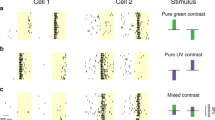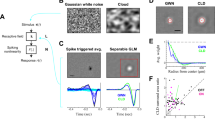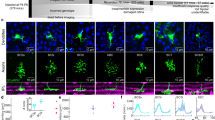Abstract
Many complex cells in mammalian primary visual cortex are finely tuned to binocular disparity. In the prevailing model, several binocular simple cells drive each disparity-tuned complex cell. However, some cat complex cells receive direct LGN input, and binocular simple cells are rare in macaque. In our biophysically detailed compartmental model, active dendrites of a single neuron perform the multiple simple-cell-like subunit computations that underlie both orientation and disparity tuning. The responses of our detailed model could be predicted by a simple algebraic formula closely related to an 'energy' model. Adding inhibitory synapses led to sharper, more contrast-invariant tuning curves. Thus active dendrites could contribute to binocular-disparity tuning in complex cells.
This is a preview of subscription content, access via your institution
Access options
Subscribe to this journal
Receive 12 print issues and online access
$209.00 per year
only $17.42 per issue
Buy this article
- Purchase on Springer Link
- Instant access to full article PDF
Prices may be subject to local taxes which are calculated during checkout







Similar content being viewed by others
References
Barlow, H. B., Blakemore, C. & Pettigrew, J. D. The neural mechanism of binocular depth perception. J. Physiol. (Lond.) 193, 327– 342 (1967).
Poggio, G. F. & Fischer, B. Binocular interaction and depth sensitivity in striate and prestriate cortex of behaving rhesus monkey. J. Neurophysiol. 40, 1392–1405 (1977).
Movshon, J. A., Thompson, I. D. & Tolhurst, D. J. Spatial summation in the receptive fields of simple cells in the cat's striate cortex. J. Physiol. (Lond.) 283, 53–77 (1978).
Hubel, D. H. & Wiesel, T. N. Receptive fields, binocular interaction and functional architecture in the cat's visual cortex. J. Physiol. (Lond.) 160, 106–154 ( 1962).
Movshon, J. A., Thompson, I. D. & Tolhurst, D. J. Receptive field organization of complex cells in the cat's striate cortex. J. Physiol. (Lond.) 283, 79–99 (1978).
Ohzawa, I., DeAngelis, G. C. & Freeman, R. D. Stereoscopic depth discrimination in the visual cortex: neurons ideally suited as disparity detectors. Science 249, 1037–1041 (1990).
Ohzawa, I., DeAngelis, G. C. & Freeman, R. D. Encoding of binocular disparity by complex cells in the cat's visual cortex. J. Neurophysiol. 77, 2879–2909 (1997).
Hubel, D. H. Exploration of the primary visual cortex, 1955–1978. Nature 299, 515–524 ( 1982).
Fleet, D. J., Wagner, H. & Heeger, D. J. Neural encoding of binocular disparity: energy models, position shifts and phase shifts. Vision Res. 36, 1839–1857 (1996).
Zhu, Y.-D. & Qian, N. Binocular receptive field models, disparity tuning, and characteristic disparity. Neural Comput. 8, 1611–1641 (1996).
LeVay, S. & Gilbert, C. Laminar patterns of geniculocortical projection in the cat. Brain Res. 113, 1 –19 (1976).
Alonso, J.-M. & Martinez, L. M. Functional connectivity between simple cells and complex cells in cat striate cortex. Nat. Neurosci. 1, 395–403 ( 1998).
Hubel, D. H. & Wiesel, T. N. Receptive fields and functional architecture of monkey striate cortex. J. Physiol. (Lond.) 195, 215–243 (1968).
Poggio, G. F., Doty, R. W. Jr & Talbot, W. H. Foveal striate cortex of behaving monkey: single-neuron responses to square-wave gratings during fixation of gaze. J. Neurophysiol. 40, 1369–1391 (1977).
Livingstone, M. S. & Tsao, D. Y. Receptive fields of disparity-selective neurons in macaque striate cortex. Nat. Neurosci. 2, 825–832 ( 1999).
Koch, C. & Poggio, T. in Synaptic Function (eds. Edelman, G. M., Gall, W. E. & Cowan, W. M.) 637– 697 (Wiley, New York, 1987).
Mel, B. W., Ruderman, D. L. & Archie, K. A. Translation-invariant orientation tuning in visual 'complex' cells could derive from intradendritic computations. J. Neurosci. 18, 4325–4334 (1998).
Rall, W. & Rinzel, J. Branch input resistance and steady attenuation for input to one branch of a dendritic neuron model. Biophys. J. 13, 648–688 (1973).
Koch, C., Poggio, T. & Torre, V. Retinal ganglion cells: a functional interpretation of dendritic morphology. Philos. Trans. R. Soc. Lond. B Biol. Sci. 298, 227–264 ( 1982).
Woolf, T., Shepherd, G. & Greer, C. Local information processing in dendritic trees: Subsets of spines in granule cells of the mammalian olfactory bulb. J. Neurosci. 11, 1837–1854 (1991).
Zador, A. M., Agmon-Snir, H. & Segev, I. The morphoelectrotonic transform: a graphical approach to dendritic function. J. Neurosci. 15, 1669–1682 (1995).
Koch, C., Poggio, T. & Torre, V. Computations in the vertebrate retina: Gain enhancement, differentiation and motion discrimination. Trends Neurosci. 9, 204–211 (1986).
Rall, W. & Segev, I. in Synaptic Function (eds. Edelman, G. M., Gall, W. E. & Cowan, W. M.) 605–636 (Wiley, New York, 1987).
Mel, B. W. in Advances in Neural Information Processing Systems Vol. 4 (eds. Moody, J. E., Hanson, S. J. & Lippman, R. P.) 35–42 (Kaufmann, San Mateo, California, 1992).
Mel, B. W. NMDA-based pattern discrimination in a modeled cortical neuron. Neural Comput. 4, 502–517 (1992).
Borg-Graham, L. J. & Grzywacz, N. M. in Single Neuron Computation (eds. McKenna, T., Davis, J. & Zornetzer, S. 347–375 (Academic, San Diego, 1992 ).
Mel, B. W. Synaptic integration in an excitable dendritic tree. J. Neurophysiol. 70, 1086–1101 ( 1993).
Johnston, D., Magee, J. C., Colbert, C. M. & Christie, B. R. Active properties of neuronal dendrites. Annu. Rev. Neurosci. 19, 165–186 (1996).
Stuart, G., Spruston, N., Sakmann, B. & Häusser, M. Action potential initiation and backpropagation in neurons of the mammalian CNS. Trends Neurosci. 20, 125– 131 (1997).
Mel, B. W., Ruderman, D. L. & Archie, K. A. in Advances in Neural Information Processing Systems Vol. 10 (eds. Jordan, M. I., Kearns, M. J. & Solla, S. A.) 208–214 (MIT Press, Cambrid ge, Massachusetts, 1998).
Sclar, G. & Freeman, R. D. Orientation selectivity in the cat's striate cortex is invariant with stimulus contrast. Exp. Brain Res. 46, 457–461 ( 1982).
Skottun, B. C., Ohzawa, I., Sclar, G. & Freeman, R. D. The effects of contrast on visual orientation and spatial frequency discrimination: a comparison of single cells and behavior. J. Neurophysiol. 57, 773–786 (1987).
Beaulieu, C. & Colonnier, M. A laminar analysis of the number of round-asymmetrical and flat-symmetrical synapses on spines, dendritic trunks, and cell bodies in area 17 of the cat. J. Comp. Neurol. 231, 180–189 (1985).
Vidyasagar, T. R., Pei, X. & Volgushev, M. Multiple mechanisms underlying the orientation selectivity of visual cortical neurones. Trends Neurosci. 19, 272–277 (1996).
Sompolinksy, H. & Shapley, R. New perspectives on the mechanisms for orientation selectivity. Curr. Opin. Neurobiol. 7, 514–522 ( 1997).
Gilbert, C. D., Das, A., Ito, M., Kapadia, M. & Westheimer, G. Spatial integration and cortical dynamics. Proc. Natl. Acad. Sci. USA 93, 615– 622 (1996).
Chance, F. S., Nelson, S. B. & Abbott, L. F. Complex cells as cortically amplified simple cells. Nat. Neurosci. 2, 277– 282 (1999).
Markram, H. & Tsodyks, M. Redistribution of synaptic efficacy between neocortical pyramidal neurons. Nature 382, 807–810 (1996).
Abbott, L. F., Varela, J. A., Sen, K. & Nelson, S. B. Synaptic depression and cortical gain control. Science 275, 220–224 (1997).
Destexhe, A. & Paré, D. Impact of network activity on the integrative properties of neocortical pyramidal neurons in vivo. J. Neurophysiol. 81, 1531–1547 (1999).
Mel, B. W. in Dendrites (eds. Stuart, G., Spruston, N. & Häusser, M.) 271–289 (Oxford Univ. Press, Oxford, 1999).
Kapadia, M., Ito, M., Gilbert, C. D. & Westheimer, G. Improvement in visual sensitivity by changes in local context—parallel studies in human observers and in V1 of alert monkeys. Neuron 15, 843–856 (1995).
Peterhans, E. & von der Heydt, R. Mechanisms of contour perception in monkey visual cortex. II. Contours bridging gaps. J. Neurosci. 9, 1749–1763 ( 1989).
McAdams, C. J. & Maunsell, J. H. R. Effects of attention on orientation-tuning functions of single neurons in macaque cortical area V4. J. Neurosci. 19, 431– 441 (1999).
Hines, M. L. & Carnevale, N. T. The NEURON simulation environment. Neural Comput. 9, 1179– 1209 (1997).
Koch, C. & Zador, A. The function of dendritic spines: Devices subserving biochemical rather than electrical compartmentalization. J. Neurosci. 13, 413–422 (1993).
Wörgötter, F. & Koch, C. A detailed model of the primary visual pathway in the cat: comparison of afferent excitatory and intracortical inhibitory connection schemes for orientation selectivity. J. Neurosci. 11, 1959– 1979 (1991).
Bernander, O., Douglas, R., Martin, K. & Koch, C. Synaptic background activity influences spatiotemporal integration in single pyramidal cells. Proc. Natl. Acad. Sci. USA 88, 11569– 11573 (1991).
Borg-Graham, L. J., Monier, C. & Frégnac, Y. Visual input evokes transient and strong shunting inhibition in visual cortical neurons. Nature 393, 369–373 (1998).
Destexhe, A., Mainen, Z. & Sejnowski, T. J. Synthesis of models for excitable membranes, synaptic transmission and neuromodulation using a common kinetic formalism. J. Comput. Neurosci. 1, 195–230 (1994).
Acknowledgements
This work was supported by the National Science Foundation. We thank Dan Ruderman for contributions to early stages of this work, and Margaret Livingstone and Gary Holt for comments.
Author information
Authors and Affiliations
Corresponding author
Rights and permissions
About this article
Cite this article
Archie, K., Mel, B. A model for intradendritic computation of binocular disparity. Nat Neurosci 3, 54–63 (2000). https://doi.org/10.1038/71125
Received:
Accepted:
Issue Date:
DOI: https://doi.org/10.1038/71125
This article is cited by
-
Illuminating dendritic function with computational models
Nature Reviews Neuroscience (2020)
-
Fast simulation of extracellular action potential signatures based on a morphological filtering approximation
Journal of Computational Neuroscience (2020)
-
Nonlinear dendritic processing determines angular tuning of barrel cortex neurons in vivo
Nature (2012)
-
Each synapse to its own
Nature (2010)



